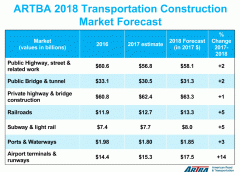The U.S. transportation infrastructure market is anticipated to rebound slightly next year, following a 2.8 percent drop in 2017, according to the American Road & Transportation Builders Association’s (ARTBA) 2018 Transportation Construction Market Forecast.
Total domestic transportation construction and related-market activity is forecast to reach $255 billion in 2018, a year-on-year increase of 3.2 percent after adjusting for project costs and inflation. The 2017 market performance is expected to come in at $247.1 billion.
“The fundamentals of this market are positive,” said ARTBA Chief Economist Dr. Alison Premo Black. “There are a lot of things going on that could help support growth in the coming years, including the local and federal investment part of it. It really depends on where you are working. We are seeing much more variation in the regional, state and even local or urban level. There are states and areas that are showing very strong, significant growth and potential for growth over the next few years.”
- The largest 2018 market growth is anticipated in California, Florida, Hawaii, New York, Virginia and Washington.
- A market slowdown in new work is anticipated in Arizona, Colorado, Delaware, Maryland, Nevada and Oklahoma. The Minnesota, New Jersey, Ohio, Texas, and Iowa markets are anticipated to hold steady.
Federal highway funding of state DOT programs provided by the 2015 FAST Act will continue to show inflationary growth in 2018, providing a degree of market stability in every state. Although there have been significant increases in state and local revenues for transportation purposes in a number of states over the past several years, some of that revenue is dedicated to debt reduction or has been delayed from reaching the transportation market due to state budget issues.
These factors, combined with receding state markets due to completion of bond programs or declining or inflation-eroded state revenues, continue to cause a drag on the overall U.S. transportation infrastructure market.
The 2017 market drop was largely driven by the overall national decline in state and local highway and bridge spending, which were down 6.4 percent and 7.7 percent, respectively.
The bright spots of the transportation construction market continue to be airport terminals, public transit, Class 1 railroads and private driveway, street and parking lot construction associated with residential and commercial developments. These markets saw real market growth in 2017, and are forecast to continue growing in 2018.
Public highway and bridge construction and related services by state DOTs and local governments, port and waterway construction and work on airport runways is expected to grow modestly in 2018, partially offsetting market declines from the previous year.
Although the market is showing overall modest growth, the impact from state to state will vary significantly, with some regions showing significant growth and others pulling back on capital investments and construction activity.
2018 transportation construction activity is expected to increase in at least 20 states and Washington, D.C., with work in another seven states remaining steady. The market is expected to be down in the remaining 23 states.
The real value of public highway, street and related work by state DOTs and local governments – the largest market sector – is expected to increase a modest 2.4 percent in 2018 after falling 6.4 percent in 2017.
Although 26 states have approved significant changes or increases in recurring transportation revenues over the last five years, the impact of these measures varies widely. In some cases the increases have translated into an increase in state DOT highway contract awards over time.
Depending on how the state increase is structured, the actual highway construction market impact can vary significantly. Such factors as lower wholesale fuel prices, state highway revenue diversions, pass through grants to local governments and other modes of transportation and debt service and repayments can impact how much of a revenue increase is passed.
Overall, highway program contract awards are up in 13 states compared to a three-year historical average, down in 26 states and Washington, D.C., and within a 5 percent range up or down in 11 states.
Six highway-related public-private partnership (P3) projects came to financial close in 2017, totaling over $7.5 billion in investment.
With major projects in some states reaching conclusion, the pace of bridge work has slowed. The public bridge and tunnel construction market is expected to increase slightly in 2018, to $31.3 billion. Work in 2017 is expected to be $30.5 billion, down from $33.1 billion in 2016.

